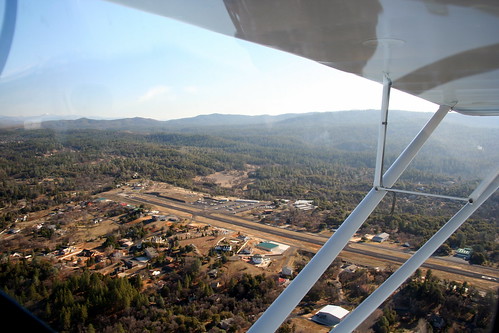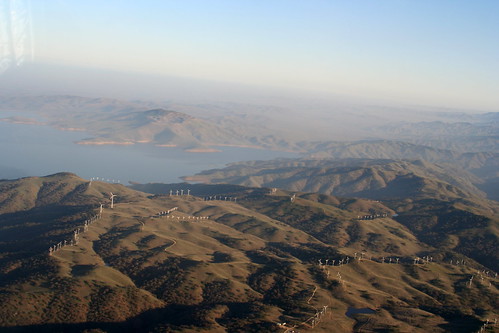January 31, 2008
I only know when you ask the question...
I have this weird mental defect that prevents me from figuring a lot of things out on my own. I can't just sit and think about a problem or question and hope to get my best answers. Often times, I only get that by engaging in a discussion with others about it and hoping that they challenge me to to think about it the right way. I'm just not good at challenging myself to think in the right way.
Or sometimes I'm part of a discussion that frustrates me because I feel like I'm the only one in the room who "gets it", so I finally speak up... explaining my entire line of thinking in a fairly short and condensed fashion. Occasionally this works and people pause for a moment, look at me, and then say "hey, that sounds right!"
That kind of happened in a meeting yesterday. But it was a brainstorming meeting, so that's okay.
Except there's one problem. They want me to write up whatever it was that I said toward the end of the meeting. Apparently I did a reasonable job of explaining some things.
The trouble is that nobody was recording it and I really remember only a fraction of what I probably said. So it's going to take me a good chunk of time today to reason out what I probably said and try to figure out how to convey that via email or a TWiki page.
Hmm.
Sometimes I wish I was always recording myself. Because every once in a while I say something worth capturing. And it never comes out as well the second time.
Where's Big Brother when you need him, anyway?
FriendFeed Comments and Likes
A couple days ago I noticed that FriendFeed added comments, meaning that you can comments on items that appear in the friends' feeds. Here's what it looks like:

That's pretty cool.
Basically, it means if you looking at my friendfeed, you could comment on a given item or indicate that you like it with a single click.
And if you haven't seen FriendFeed, it's a service that takes the Facebook activity stream idea and implements it across a bunch of services, including Google Reader, blogs, del.icio.us, Digg, Flickr, Furl, Twitter, Reddit, Netflix, and more.
I suppose there will be a standard way to syndicate and aggregate this stuff someday--probably something like Atom or RSS. But until then, it seems that FriendFeed has the lead in this area.
Also noted: the new FriendFeed bookmarklet
January 29, 2008
Richard Stallman is Getting Things Done (GTD). Old School.
Thanks to Andy Baio's Personal Ads of the Digerati, I've discovered one of them most remarkable productivity tools of the modern age.
It seems that Richard Stallman doesn't use a web browser.
At all.
As seen in the archives of the misc@openbsd.org list, he uses email to browse the web. Sort of...
For personal reasons, I do not browse the web from my computer. (I also have not net connection much of the time.) To look at page I send mail to a demon which runs wget and mails the page back to me. It is very efficient use of my time, but it is slow in real time.
Yikes.
That is sooooo old school.
Merlin Mann would be proud. Very proud. And probably a little scared.
Speaking of which, go watch Inbox Zero again.
Expensive SMS Messages? You bet.
I've never been a big user of SMS messaging on my cell phone, but I know that the kids are all over it these days--when they're not all over my lawn, that is. :-)
Seriously, though, paying per-message costs always seemed rather silly. So it was with great amusement that I read The True Cost of SMS Messages and discovered that they're about 61 million times more expensive than TCP/IP from your typical Cable Modem service.
The article is rather fun. You can read a whole line of reasoning that compares SMS costs with the postal service and home broadband. The conclusion cracked me up.
COSTS OF TRANSFERING 2,560 MP3s:
TCP/IP: $1
TCP/SMS: $61,356,851.20
TCP/USPS: $307,072.00 (Bits written out on paper)
So getting a SMS delivered is bit for bit 200x more expensive than getting a message hand delivered to your doorstep anywhere in the United States.
What exactly justifies making SMS messages sixty one million times more expensive than ISP data and 200x more expensive than TCP/USPS? How come technology, communication, and infrastructure is getting cheaper while the costs of SMS messages are increasing exponentially? My theory: SMS messages are transfered over air made of solid gold.
Heh.
In other words, save your pennies if you can't buy SMS in bulk.
January 28, 2008
YUI Grid CSS and Grid Builder Kick Ass!
Okay, I'm not a front-end web guy. Not by any stretch of the imagination. So I tend to ignore a lot of Javascript and CSS stuff unless it's clearly and obviously useful to me. And while I've heard tons of praise for YUI, the Yahoo User Interface library, I'd mostly assumed it was stuff for other people--you know, the ones who understand all that stuff.
But I recently came across a link to the YUI Grids Builder and started playing with it. In about 20 seconds, I realized that I could use that as the framework to finally redo the horrible hack that is my blog layout.
So I did. (that link is temporary and will vanish soon)
It's not done yet, but it's faster, uses less code, looks good (and more consistent) on more browsers, and requires less of my mental energy to maintain. I get to take advantage of the YUI team's expertise and focus a bit more on the stuff I care about.
Anyway, I have a bit of template editing and tweaking of fonts and pruning and stuff to do, but I'm looking forward to throwing away the old and using the new. More on that later.
In the meantime, if you haven't played with the builder or at least read about YUI Grid CSS, take a few minutes and do so. It's really useful stuff and very well documented.
If you end up using it for your site, you'll also likely find yourself reading about YUI Reset CSS as well. And it may sort of freak you our or annoy you at first, but it's really a good thing in the long run if consistency is what you're after.
Anyway, enough of this commercial. I just wish YUI had existed a few years ago when I spent many, many hours tripping over my own lack of CSS knowledge. They've made this stuff so damned easy.
January 25, 2008
Perl as a Web Scripting Language
Had I not been at work, I might have nearly fallen off my seat laughing as I read item #3 in You Used Perl to Write WHAT?! on page 2. You see, the author is taking about where Perl is good and bad, and he says "there are some uses that just aren't right." That' followed by a list of items. Here's number three.
As a Web scripting language: One of the earliest usages of perl, as the Web evolved, was for CGI programming webpages. As a result, perl has some pretty strong packages for dealing with Web forms. There is also support for embedding perl into HTML in the same way the Java is embedded into JSP pages.
However, I would argue that more modern Web scripting languages, such as PHP and Ruby on Rails, offer more out-of-the-box Web support and a cleaner integration into the webpage experience. You should especially avoid using perl for traditional CGI-style form processing; this code tends to be hard to read and maintain because the HTML ends up inlined inside the perl code.
Uhm, WHAT?!
Now maybe it's the fact that I started coding in Perl about 12 years ago. Or maybe it's the fact that I've used it quite successfully in various web projects over the years. But suggesting that Perl isn't a good web scripting language is rather laughable.
Seriously.
Now, if you're starting from scratch and looking to learn a new language primarily for building web applications, that's one thing. Sure, look at PHP, Ruby, Python, and whatever else can do the job. But the author seems to be saying that it's worth learning yet another language simply for building web applications.
That's messed up.
Have a look around CPAN and at the web frameworks that exist around Perl and mod_perl. Heck, some of them have been around a long time and are quite mature. Saying that Perl "has some pretty strong packages for dealing with Web forms" doesn't really capture the true state of things.
I think programming language battles are as dumb as the next person, so I generally try to avoid them. But when I see stuff like this, it's hard to keep my mouth shut.
As for the claim that traditional CGI-style form processing being hard to read and maintain... WHAT?! There's nothing hard about separating the HTML from the code.
Okay, enough of my griping...
Thanks to the folks at TechCzar for translating my tech blog posts and including them in their blog network.
January 23, 2008
Jobs: Business Analyst and Program Manager in D.C. Area
I've been terribly remiss in not highlighting some of the technology jobs popping up on my job board in recent months. It's a new year and I'm mostly back in the saddle, so it's time to change that.
Today we have two jobs in the Washington D.C. area, both at Gratis Internet:
Business Analyst
Gratis Internet is constantly pursuing new initiatives across our multiple business lines. It is not unusual for the company to identify an opportunity on a Monday and release a new product by the end of the week. We have an immediate opening for a BA to help us conceive of and execute against new ideas.
Unlike most BA roles, this position reports to the VP of Engineering and works closely with the engineering team.
visit the full job posting for requirements, responsibilities, and perks
Program Manager
Gratis Internet is constantly pursuing new initiatives across our multiple business lines. It is not unusual for the company to identify an opportunity on a Monday and release a new product by the end of the week. We have an immediate opening for a PM to help us launch these products.
In addition to technical skills, the position requires the ability to analyze business requirements, document the needs of the company, and coordinate the rapid development of new software projects. Reports to the VP of Engineering.
visit the full job posting for requirements, responsibilities, and perks
If you're a hiring manager, recruiter, or head hunter looking for qualified tech candidates, you can list a job opening. If you do, please email me so that I may recognize it in a list like this.
Remember, even if you're happily employed and not looking for work, your friends may not be. Pass the word!
January 21, 2008
$100 Hamburger at Merced and Air to Air Pictures
On Friday I got email from a few other pilots suggesting various fly-in ideas for the weekend. After thinking about it a bit, we opted to join Chris and a few others for a late morning flight to Merced Airport for the proverbial $100 hamburger.
If you're not familiar with the expression, Wikipedia captures it well:
A $100 Hamburger is aviation slang for a private general aviation flight for the sole purpose of dining at a non-local airport. Most often used by pilots who are looking for any excuse to fly, a $100 hamburger trip usually involves flying a short distance (less than two hours), eating at an airport restaurant, and flying home. "$100" originally referred to the approximate cost of renting or operating a light general aviation aircraft, such as a Cessna 172, for the time it took to fly round-trip to a nearby airport. Increasing fuel prices have since caused an increase in hourly operating costs for most airplanes, whether rented or owned.
So, anyway, Kathleen and I headed to Reid-Hillview airport on Saturday morning to get the Citabria ready for the adventure. While there we met Chris and his brother Michael who were flying their new [to them] Citabria 7GBCB (N8643V). Also joining us was Ryan, flying his Cessna 150 from Auburn, and Curtis flying his Cub along with someone whose name I've forgotten.
After getting the airplane ready and briefing the plan, we departed Reid-Hillview and headed down toward Hollister where the Cub had already departed.
As we headed past the Coyote Reservoir and toward Pacheco Pass, Chris began to catch up with us and we began the formation flying and air to air photography.
We got some good shots with the San Luis Reservoir in the background too.
After several minutes of that, Chris took the lead and shot some pictures of us. They're not on-line yet but check his web site (StickAndRudderPhoto.com) or Flickr photostream to see if they appear.
Then it was time to head in for landing at Merced...
Before long, we were tied down and ready to meet up with the others...
We all parked in a row and headed over to the Hangar Cafe for lunch. True to cliche, most of us ordered the burger. :-)
After lunch we spent some time checking out each other's airplanes before heading out. Most of the group headed toward a fly-in at the Tracy airport, but we opted for most sight seeing.
We headed out toward Pine Mountain Lake for a look around and a low pass.
On downwind...
Setting up for the low pass...
And then off toward Yosemite National Park for a look at Half Dome.
First, we saw some very blue lakes with the snow-capped mountains in the background.
Then we flew up the Yosemite Valley...
And then got some good looks at Half Dome.
First from one side...
And then the back side...
Once that was done, it was time to head back home to San Jose.
We had to cross the hazy Central Valley...
And then flew over Pacheco Pass...
Before flying over Silver Creek...
On our approach to Reid-Hillview, including the Eastridge Mall...
All in all it was a fun day of flying.
Ryan, the Cessna 150 pilots, posted his pictures here. Chris sent me a bunch of the pictures he shot of our airplane, but I haven't posted them anywhere (yet?).
I have more pictures of the flight on Flickr.
January 17, 2008
OpenID at Yahoo!
![]() It feels good to be able to talk publicly about Yahoo's OpenID support (developer info). :-)
It feels good to be able to talk publicly about Yahoo's OpenID support (developer info). :-)
It's been in the works for a while and I was one of the early squeaky wheels poking people to see if we could get on board. You can see the official press release or the story on TechCrunch. But no matter where you read it, this is big news.
Both yahoo.com and flickr.com will act as OpenID 2.0 providers. That means starting soon any Yahoo! or Flickr user can sign in to an OpenID 2.0 enabled site simply using a reference to yahoo.com or flickr.com.
I've been a fan of OpenID for a long time--not just because of it's simplicity but because of the philosophy behind it. It puts more control in the hands of us: the end users. And it's another milestone in Yahoo! opening up more and more. In fact, I wrote about it almost exactly one year ago in The Tipping Point for OpenID.
Who knows. Maybe OAuth support isn't far off?
Oh, and before anyone jumps on me about this not being "full" (meaning bi-directional) OpenID support, I'm quite aware of that. Consuming OpenID is a different beast that can't happen overnight. Give it some time. I'm optimistic that we'll get there.
January 16, 2008
Congrats to MySQL AB and Sun!
 As long-time readers here know, I've been a fan of MySQL for many, many years--so much that I even wrote a book about it. It's a fantastic product that's unmatched in many ways. Over the years, I've had the pleasure of getting to know many of the early folks at MySQL AB, including the Monty and David (co-founders), Marten (CEO), numerous engineers (Brian, Jim, Mark), sales folks (Kerry, Larry), and so on.
As long-time readers here know, I've been a fan of MySQL for many, many years--so much that I even wrote a book about it. It's a fantastic product that's unmatched in many ways. Over the years, I've had the pleasure of getting to know many of the early folks at MySQL AB, including the Monty and David (co-founders), Marten (CEO), numerous engineers (Brian, Jim, Mark), sales folks (Kerry, Larry), and so on.
So I was very happy to see the announcement this morning that Sun is Buying MySQL AB. Sun is a great company that really gets Open Source and is making some big and very smart bets on it for their future. I think it's a great home for MySQL.
There's some smart thinking going on over at Sun these days. That Jonathan guy has a good head on his shoulders. :-)
Congrats again to everyone involved!
January 15, 2008
Using Gmail to read those damned winmail.dat files!
A few times a week I get email from some sorry Outlook/Exchange user which contains a dreaded winmail.dat file. Being a Thunderbird user, this presents a bit of a problem--one that has been well documented in Dealing with the winmail.dat file and unreadable attachments and How to Prevent the Winmail.dat File from Being Sent to Internet Users.
The are various "free" winmail.dat readers around, but this is 2008 not 1998. I shouldn't have to install the email equivalent of a "helper application" to read a fucking word doc that crappy email software couldn't encode in a sane format.
So anyway, I got one today and actually needed to read it. And I hadn't installed one of those stupid winmail.dat decoders since I had my laptop replaced. Faced with the prospect of actually installing software I wondered what'd happen if I forwarded a copy of the message to my Gmail account.
Well, wouldn't ya know it? The damned thing came through just fine. I was able to extract the attachment and open it faster than you can google "free winmail.dat decoder."
Kick Ass.
Just for kicks, I sent it to my dormant Yahoo! Mail account too... and it was also able to extract the Word document from the winmail.dat file.
Now why on earth hasn't this functionality been built into Thunderbird? Or Windows for that matter?
It's days like this that I might confuse my laptop for a stone tablet... just for a moment or two.
January 14, 2008
The Blu-Ray and HD DVD Stupidity. When will it end?
 Reading Douglas Crockford's Format War post reminded me of how hopeful I was last Fall. I was nearly certain that the Blu-Ray vs. HD DVD format war would have been settled by Giftmas, so that we could just buy the winning format and go on with life.
Reading Douglas Crockford's Format War post reminded me of how hopeful I was last Fall. I was nearly certain that the Blu-Ray vs. HD DVD format war would have been settled by Giftmas, so that we could just buy the winning format and go on with life.
Instead, we're stuck with the uncertainty of not knowing who will win. Beta or VHS? Err, I mean "Blu-Ray or HD-DVD?" Why must we endure this stupidity again?
I'm content to sit on the sidelines, impatiently, waiting for the scales to finally tip so far in one direction that we have a clear winner. Then it'll be time to buy a nice cheap player and finally put my HD TV to good use.
Or maybe it'll take so long that we'll bypass the discs altogether and stream the HD video on-line from Netflix, Amazon, or whoever.
That wouldn't be half bad either.
African Beef
 While there is much to write about our recent African Safari (we got back safely--thanks to everyone who asked!), one particular thing that really stands out is the African Beef we ate during our weeks in Kenya and Tanzania.
While there is much to write about our recent African Safari (we got back safely--thanks to everyone who asked!), one particular thing that really stands out is the African Beef we ate during our weeks in Kenya and Tanzania.
You see, nearly every place we stayed had a nice big buffet dinner (don't ask about the diet) that featured excellently prepared African Beef. In every case the beef was incredibly tender, lean, and very tasty. It was hands-down better than the vast majority of beef we've had in the United States.
After a few days of this, I got to thinking about why the beef was so good. Here's my thinking on it. The beef we had in Africa was often very fresh. They don't transport it in from nearly as far away as we often do in the United States. And the cows aren't fed the sort of unnatural diets that they are here too. Most of them are out grazing the countryside, eating whatever grass and other greens catch their eye. In other words, they're left in their natural environment rather than being cooped up in some industrialized beef manufacturing system.
The locals I talked with seemed to agree. The combination of locally raised cows eating what they're supposed to eat really makes from some excellent eating.
If you're planning to visit Kenya or Tanzania, plan to enjoy some amazing beef. It's a real treat. :-)
Previously:
January 09, 2008
Married in Zanzibar!
The end of our big Africa trip is nearly here. The travel through Kenya went well despite the reported violence, demonstrations, and so on. We've been in Zanzibar for the last several days for a little beach time and even a wedding. :-)
On January 8th, 2008 we were married on the beach during a breezy and sunny day. It was a great ceremony in an excellent location and I'll surely write a lot more about it (and the rest of the trip) later. But we need to start our day of travel back to the USA and the harsh reality of not living on a beach resort.
We'll be heading back via Nairobi, London, and finally San Francisco. In the meantime, here are a few more wedding pictures. We'll upload more in a few days--not to mention billions of safari pictures.
See you all in a few days, and thanks for all the good wishes!

















